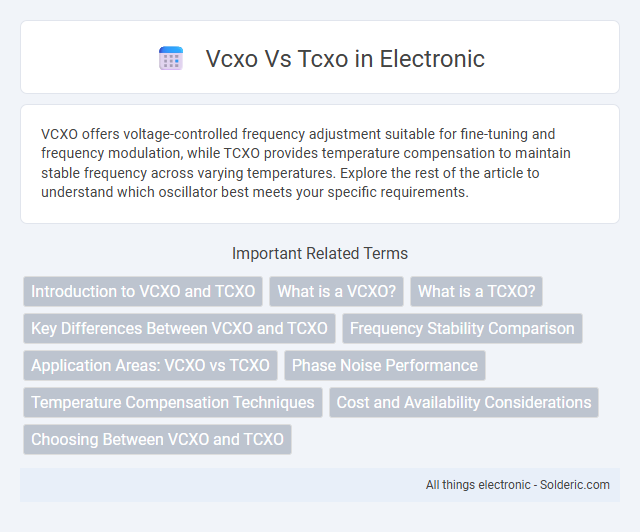VCXO offers voltage-controlled frequency adjustment suitable for fine-tuning and frequency modulation, while TCXO provides temperature compensation to maintain stable frequency across varying temperatures. Explore the rest of the article to understand which oscillator best meets your specific requirements.
Comparison Table
| Feature | VCXO (Voltage Controlled Crystal Oscillator) | TCXO (Temperature Compensated Crystal Oscillator) |
|---|---|---|
| Frequency Stability | Moderate, adjustable via control voltage | High, stable across temperature variations |
| Control Mechanism | Voltage control for frequency tuning | Internal temperature compensation circuit |
| Typical Applications | Phase-locked loops, radio tuners, frequency synthesis | GPS, cellular communication, precision timing |
| Temperature Sensitivity | High, frequency drifts with temperature changes | Low, frequency compensation minimizes drift |
| Cost | Lower cost, simpler design | Higher cost due to compensation circuitry |
| Frequency Range | Narrow tuning range via voltage | Fixed frequency with minimal deviation |
Introduction to VCXO and TCXO
VCXO (Voltage-Controlled Crystal Oscillator) offers frequency tuning through voltage variations, enabling fine frequency adjustments in communication and signal processing devices. TCXO (Temperature-Compensated Crystal Oscillator) maintains frequency stability by compensating for temperature fluctuations, ideal for precision timing applications in GPS and wireless systems. Both oscillators enhance device performance by addressing different stability requirements in electronic circuits.
What is a VCXO?
A VCXO (Voltage-Controlled Crystal Oscillator) is a crystal oscillator whose output frequency can be finely adjusted via an external control voltage, enabling precise frequency tuning in electronic circuits. Commonly used in phase-locked loops (PLLs) and communication systems, VCXOs provide frequency stability with the flexibility of real-time correction. Unlike TCXOs (Temperature-Compensated Crystal Oscillators), which maintain frequency accuracy by compensating for temperature variations, VCXOs prioritize voltage-controlled frequency modulation for dynamic adjustments.
What is a TCXO?
A Temperature-Compensated Crystal Oscillator (TCXO) is a type of crystal oscillator designed to maintain stable frequency output despite temperature variations by using an internal temperature sensor and compensation circuitry. TCXOs provide higher frequency stability compared to standard crystal oscillators and are essential in applications requiring precise timing over a wide temperature range, such as GPS devices and communication systems. Your choice between a VCXO and TCXO depends on whether you prioritize fine frequency tuning or robust temperature stability.
Key Differences Between VCXO and TCXO
VCXO (Voltage-Controlled Crystal Oscillator) allows frequency adjustment through an applied voltage, ideal for fine-tuning in communication systems, while TCXO (Temperature-Compensated Crystal Oscillator) maintains frequency stability by compensating for temperature variations, used in precision timing applications. You should choose VCXO when dynamic frequency control is required, whereas TCXO excels in environments with fluctuating temperatures demanding consistent frequency output. Both oscillators leverage quartz crystal technology, but their compensation methods define their ideal use cases.
Frequency Stability Comparison
VCXO (Voltage-Controlled Crystal Oscillator) offers moderate frequency stability typically around +-20 to +-50 ppm, with performance dependent on voltage input and temperature variations. TCXO (Temperature-Compensated Crystal Oscillator) provides enhanced frequency stability, often within +-0.5 to +-2 ppm, by compensating for temperature-induced frequency drifts using internal electronic circuitry. For applications requiring precise and stable frequency over a wide temperature range, TCXO is generally preferred due to its superior stability compared to VCXO.
Application Areas: VCXO vs TCXO
VCXO (Voltage-Controlled Crystal Oscillator) excels in communication equipment, phase-locked loops, and frequency modulation applications due to its precise frequency tuning capabilities. TCXO (Temperature-Compensated Crystal Oscillator) dominates in GPS devices, mobile phones, and precision timing systems because of its superior frequency stability across temperature variations. The choice between VCXO and TCXO depends on requirements for tuning accuracy versus environmental stability in sectors like telecommunications, consumer electronics, and aerospace.
Phase Noise Performance
VCXO (Voltage Controlled Crystal Oscillator) typically offers lower phase noise due to its simpler design and direct control over frequency, making it suitable for applications requiring high signal purity. TCXO (Temperature Compensated Crystal Oscillator) improves frequency stability over temperature variations but may exhibit slightly higher phase noise because of its compensation circuitry. Your choice depends on whether phase noise performance or temperature stability is more critical for your system's operation.
Temperature Compensation Techniques
VCXO (Voltage-Controlled Crystal Oscillator) relies on voltage adjustments to fine-tune frequency but lacks inherent temperature compensation, resulting in frequency drift with temperature changes. TCXO (Temperature-Compensated Crystal Oscillator) incorporates precise temperature compensation techniques using internal temperature sensors and compensation networks to minimize frequency variation across temperature ranges. This compensation typically involves using analog or digital circuits that adjust the frequency output based on real-time temperature measurements, ensuring higher stability in critical applications.
Cost and Availability Considerations
VCXOs (Voltage-Controlled Crystal Oscillators) generally offer lower cost options due to simpler design and widespread manufacturing availability, making them suitable for budget-sensitive applications. TCXOs (Temperature-Compensated Crystal Oscillators) typically incur higher expenses attributed to integrated temperature compensation circuits and specialized calibration processes, which can limit their accessibility in bulk procurement. Availability for VCXOs is usually higher across multiple vendors, whereas TCXOs may require sourcing from specialized manufacturers with longer lead times and minimum order quantities.
Choosing Between VCXO and TCXO
Choosing between VCXO (Voltage-Controlled Crystal Oscillator) and TCXO (Temperature-Compensated Crystal Oscillator) depends on application requirements for frequency stability and tuning capability. VCXOs provide precise frequency adjustments via voltage control, ideal for systems needing dynamic frequency modulation or synchronization. TCXOs offer superior temperature stability, maintaining consistent frequency across varying environmental conditions without external control voltage.
vcxo vs tcxo Infographic

 solderic.com
solderic.com